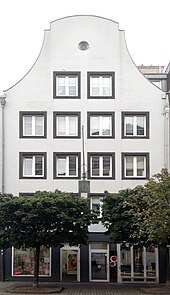House of the "Prince of Orange"


The house of the “Prince of Orange” at Burgplatz No. 12 in Düsseldorf was an art-historical example of the Renaissance. The building, built in 1584, was honored by Paul Sültenfuß in Das Düsseldorfer Wohnhaus until the middle of the 19th century and by Hans Vogts in Das Bürgerhaus in der Rheinprovinz for its gable shape. Boris Becker praised the house as an example of the eclecticism of the Wilhelminian era, in which forms of classicism, renaissance and baroque were combined on one and the same facade.
Location and surroundings
The house was opposite the Hauptwache, close to the Electoral Palace and the famous picture gallery. The location in the middle of the city was considered "very well situated" .
history
In 1632 the house was owned by Heinrich Mum, who is mentioned as the oldest of the Reformed community. In 1688 it was still owned by the Momm family, after which the Kegeljan family lived there, who ran the “Prince of Orange” auberge and inn and where the lords, merchants and travelers were accommodated and entertained. The house was known for its "beautiful view of the Electoral Palace and the spacious square, the proximity of the famous gallery, the furnished and papered rooms in the house, the spacious stables and coach houses, good wine and food" . In 1784 the widow Kegeljan gave up the business and the inn was taken over by the innkeeper of the "Zum golden Anker" from Marktstrasse on July 28th in the same year. Since then the house has been called "Zum Goldenen Anker". The innkeeper Wallenkamp was there in 1817 and the innkeeper Max Ebertz in 1889, who ran an inn in an “original, hilarious way”. Ebertz, for example, was in the habit of “giving a glass of beer to anyone who could show the digestion of onion or pea soup in his restaurant in the familiar carter style. So early in the morning the Penn brothers crowded to Ebertz Max to earn a glass of beer ” .
In 1932, on the 100th year of Goethe's death , a bronze plaque was attached to the town house : Goethe lived in this house in July 1774, the former Prince of Orange inn . Goethe had arrived in Düsseldorf from Cologne on July 21, 1774 to visit the Jacobi brothers. "... the house was empty, the rulers were away," wrote Goethe to the equally absent Betty Jacobi. So he chose the “Prince of Orange” as emergency quarters, which was exactly opposite the east wing of the picture gallery . The next day the first meeting with Fritz Jacobi took place, in the evening they drove together to Pempelfort to the Jacobisches Landgut .
Art historical significance
The house was built in 1584 and remodeled in 1850. The building police office has a representation before the renovation. In the Historical Museum there is a watercolor of the former building on the corner of Kurzestrasse and Burgplatz. The corner building at Burgplatz 12 is a “typical example” of how the gable of a corner building should particularly emphasize the block of houses and thus also the street end. It is also exemplary for the beginning of the Düsseldorf renaissance, when the "conservative direction" with its "curly pinnacle gables" still stood. The house was 9 meters wide and 12 meters deep. The design of the gable "is very close to that of the town hall" .
In the 19th century the house was rebuilt in an eclectic style. According to Boris Becker , the house is an example of the “typical changes that old town houses from the 16th and 17th centuries were subjected to during the early days of the company. The street view of the house at Burgplatz 12 reveals the eclecticism of those years. Forms of classicism, renaissance and baroque meet here on one and the same facade "
Individual evidence
- ^ A b c Heinrich Ferber: Historical walk through the old city of Düsseldorf. C. Kraus, Düsseldorf 1889. Reprint: Triltsch-Verlag, Düsseldorf 1980, I, p. 72.
- ↑ Hans Müller-Schlösser: The beautiful old Düsseldorf. Düsseldorf 1911, p. 79.
- ↑ Hans Müller-Schlösser: The beautiful old Düsseldorf. Düsseldorf 1911, p. 79.
- ^ Heinrich Ferber: Historical walk through the old city of Düsseldorf. C. Kraus, Düsseldorf 1889. Reprint: Triltsch-Verlag, Düsseldorf 1980, I, p. 71.
- ^ Paul Sültenfuß: The Düsseldorf house until the middle of the 19th century . In addition table work in large folio with 75 sheets, Aachen 1922, p. 40.
- ↑ Hans Vogts: Das Bürgerhaus in der Rheinprovinz , Düsseldorf 1929, p. 213. (from the series: Association of German Architects and Engineering Associations (ed.): The community center in the German Empire and in its border areas , printing and publishing house L.Schwann In Dusseldorf).
- ^ Paul Sültenfuß: The Düsseldorf house until the middle of the 19th century . In addition table work in large folio with 75 sheets, Aachen 1922, p. 48a.
- ^ Paul Sültenfuß: The Düsseldorf house until the middle of the 19th century . In addition table work in large folio with 75 sheets, Aachen 1922, p. 32.
- ^ Boris Becker: Düsseldorf in early Photographien 1855–1914 , Schirmer / Mosel, Munich 1990. Plate 16.
Coordinates: 51 ° 13 ′ 35.2 ″ N , 6 ° 46 ′ 20.5 ″ E

